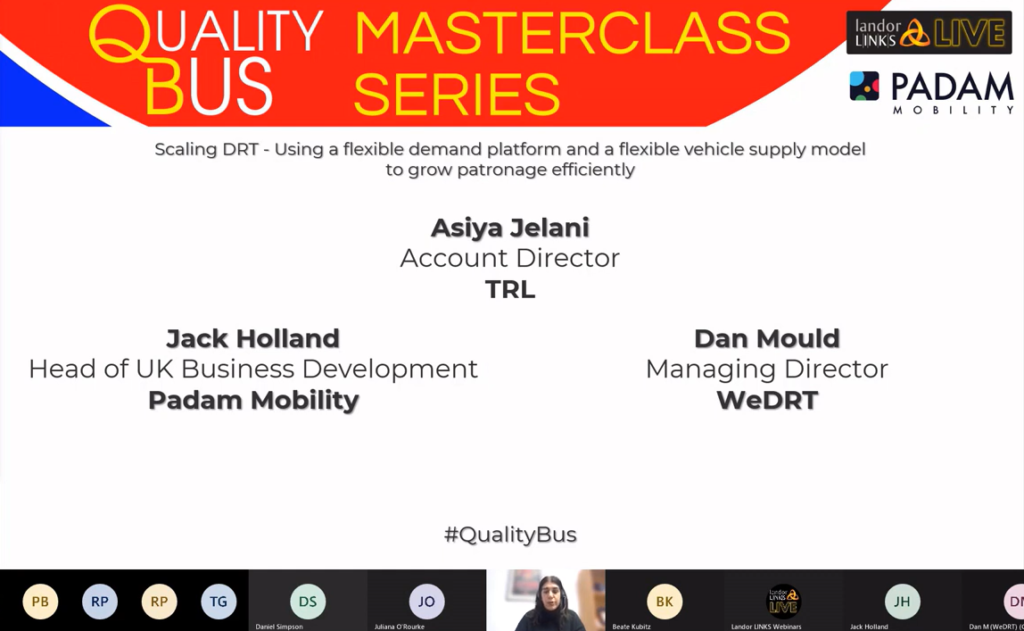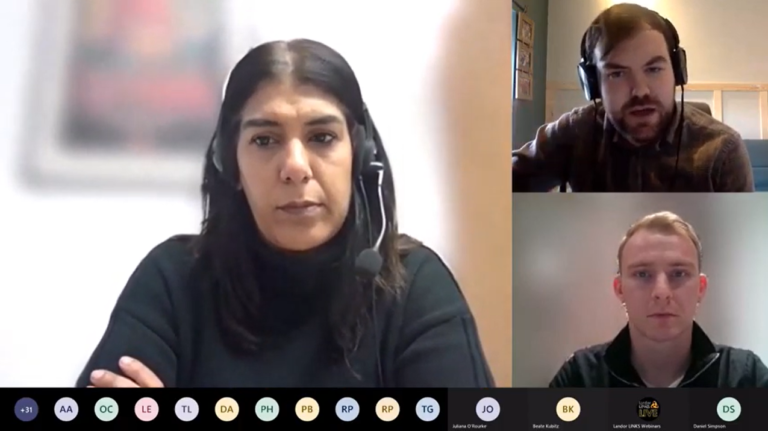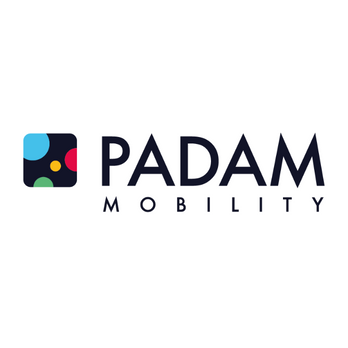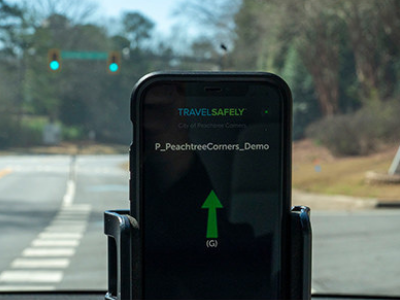Scaling DRT – Using a Flexible Demand Platform and a Flexible Vehicle Supply Model to Grow Patronage Efficiently
This Masterclass, on scaling, was the third in a three-part series of expert discussions covering the details of successful implementation of Demand Responsive Transport systems. The Padam Mobility Masterclass series was run in cooperation with Landor Links.

In the final edition, Asiya Jelani, Account Director at TRL and Women in Transport Board Member spoke with Daniel Mould, Managing Director at WeDRT and Jack Holland, Head of Business Development at Padam Mobility about how DRT services can be effectively introduced and scaled to achieve optimal coverage and economic viability.
What is Scaling?
Scaling is essentially matching the number of vehicles to demand efficiently, as your DRT service grows. It’s possible to predict that services will grow from the outset with modelling.
However, Jack Holland, Head of Business Development at Padam Mobility, explained that it can also be planned once a service is in operation:Scaling is not a gut feeling decision, but is carefully planned and decided during the run phase of a DRT service based on specific KPIs. This might relate to user numbers or pooling rates (the number of passengers on the bus at the same time) in a particular area, for example. If the available vehicles are constantly at capacity, this may be an indication that demand is not being served well enough and that potential users are unable to find a free vehicle at their desired time. These observations provide initial indications that an on-demand service needs to be adapted.
As DRT can be configured to fit into local transport networks, it can be used to grow the overall ridership.
Jack Holland continues:Efficient scaling depends primarily on the local conditions in which a DRT service operates. A service is only optimally used if it fits seamlessly into the structural transport network, i.e. if it brings passengers to major public transport hubs. In this context, the procurement of the DRT software plays a crucial role. On-demand services, which act as a complement to the scheduled network, can be configured in such a way that users are pointed to scheduled transport options in the app at certain times rather than booking a DRT vehicle for the desired trip.
The ability to flex the fleet is also key. The WeDRT platform enables services to access properly registered and accredited fleet when services need more vehicles to meet demand. This is also useful when piloting the service or to test the market for additional areas or times of day when building ridership.
What About Financing?
The expansion of transport services is generally assumed to imply an increase in costs, which means financing is a key concern. How can it be possible for an on-demand service to be economically viable?
For Jack, this question needs to be tackled more holistically:We live in a deregulated mindset but we need to look holistically at where we spend money on transport and how we can cross-subsidise different modes so that the overall cost is reduced for the local authority. That is how you make DRT viable in the UK. It is looking at these different subsidy pots, be it home to school, be it dial-a-ride, even be it corporate shuttles and how you can blend these different models.
However, regardless of external funding measures, it can also be possible to deploy a transport service in a way that is both demand-responsive and resource-efficient.
Dan Mould, Managing Director at WeDRT, added:Technical possibilities, such as well-deployed DRT software, help transport companies to use their fleet much more effectively. Intelligent pooling allows for better utilisation of vehicles, which means that in many cases the total fleet can be significantly reduced, which in turn saves costs.
Jack added:While it is currently almost impossible to offer a profitable on-demand service, it is certainly possible to set the parameters in a way that lowers expenses. At around 8 passengers per hour, a DRT service is considered economically viable. When demand is low, however, it is conceivable to reduce resources or, even better, to reallocate them to other use cases in order to relieve the cost to the public purse, e.g. for ambulance transport, school transport or company shuttles.
Scaling – The Right Pace
Predicting the vehicle requirement for DRT can be very challenging. It is not easy to assess from the outset whether or not a service area should be expanded or more vehicles deployed. Making the wrong decision can have a negative impact on performance. On the one hand, having too many vehicles or a too extensive service area can generate enormous costs; on the other hand, under-provision of DRT services can lead to disappointment on the part of users. A flexible supply base is one solution.
Dan Mould:What we have seen in the market, and where the opportunities lie to make this more efficient, is flexible supply. If you have a core of your minimum supply base, for example, three minibuses, then you can flexibly mobilise the fourth minibus, which you may not be certain to use, through the WeDRT system.
This ability is a real asset for on-demand service operators because both an underused fleet and an unfulfillable demand will eventually damage the service.
Determining the fleet size and other parameters as accurately as possible – for example during the initial test phase – comes down to the right model design and analysis of the area.
Jack Holland explains:It is crucial to study the exact needs and circumstances of a particular region and then deploy a DRT service where it best complements, not competes with, the existing infrastructure. Scaling can mean starting in a very small area and introducing, for example, an initial feeder service to the main railway station. If this service proves successful, further stops can be added or new use cases identified.
DRT Services in France and the UK – A Fair Comparison?
Padam Mobility’s DRT service in the area surrounding Paris – TAD IDFM – is a very successful example of scaling. The service has been gradually extended to cover 40 service areas to date. It coordinates 8 different transport operators on a single platform, which simplifies travel for people living in Paris suburbs.
Whilst transport policies and the funding frameworks in the UK and France are very different, what we can learn is that people living in areas underserved by public transport will respond positively when they are connected to the public transport network using DRT.
Scaling – What are the Take-Aways?
The ability to scale a service is another very important success factor for a functioning DRT service. So what are the most important insights our experts would like to share?
Jack Holland:Start small, have clear KPIs in place. If the KPIs are achieved look for growth, if the KPIs aren’t achieved look for something else. So, have a clear plan of where you launch, what your KPIs are, in terms of patronage, in terms of revenue, in terms of passenger experience. Use them as your basis and then look to expand from there and scale.
Dan Mould:You will never be able to simulate exactly what the demand or the optimal supply should be. You just want to have that foundation in the early stages to be able to scale efficiently. You need to have the set-up you need to react to data that comes in.

The masterclass on “Scaling” is the third and final webinar in the current series, run by Padam Mobility and Landor Links. The other events in this series covered the topics “Data Analysis of DRT Services“ and “Integrated Ticketing“. Click on the respective topics to access the corresponding YouTube video. You can find the corresponding articles under these links:
#1 A smart ticket to ride – Ask the experts!
#2 Using Data Science to increase the success of your DRT scheme
On-demand mobility can be a very important component in providing an effective, user-friendly public transport system. We believe that it’s important to share our experience of the implementation of DRT services with public transport authorities and operators and show how on-demand services could play an important role in BSIPs. We’re always happy to talk about how DRT can improve your bus network. Just contact Jack Holland or David Carnero directly.
This article was originally published by Padam Mobility.








